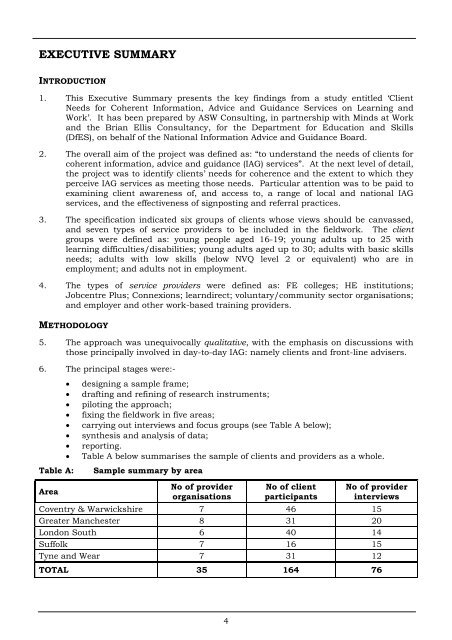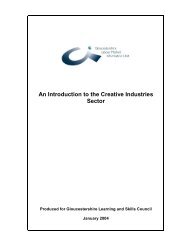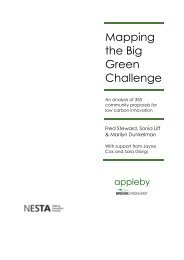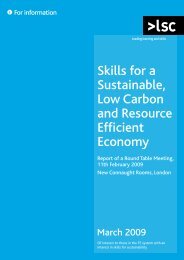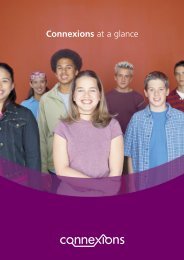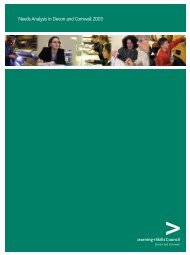Client needs for coherent information, advice and guidance services ...
Client needs for coherent information, advice and guidance services ...
Client needs for coherent information, advice and guidance services ...
You also want an ePaper? Increase the reach of your titles
YUMPU automatically turns print PDFs into web optimized ePapers that Google loves.
EXECUTIVE SUMMARY<br />
INTRODUCTION<br />
1. This Executive Summary presents the key findings from a study entitled ‘<strong>Client</strong><br />
Needs <strong>for</strong> Coherent In<strong>for</strong>mation, Advice <strong>and</strong> Guidance Services on Learning <strong>and</strong><br />
Work’. It has been prepared by ASW Consulting, in partnership with Minds at Work<br />
<strong>and</strong> the Brian Ellis Consultancy, <strong>for</strong> the Department <strong>for</strong> Education <strong>and</strong> Skills<br />
(DfES), on behalf of the National In<strong>for</strong>mation Advice <strong>and</strong> Guidance Board.<br />
2. The overall aim of the project was defined as: “to underst<strong>and</strong> the <strong>needs</strong> of clients <strong>for</strong><br />
<strong>coherent</strong> in<strong>for</strong>mation, <strong>advice</strong> <strong>and</strong> <strong>guidance</strong> (IAG) <strong>services</strong>”. At the next level of detail,<br />
the project was to identify clients’ <strong>needs</strong> <strong>for</strong> coherence <strong>and</strong> the extent to which they<br />
perceive IAG <strong>services</strong> as meeting those <strong>needs</strong>. Particular attention was to be paid to<br />
examining client awareness of, <strong>and</strong> access to, a range of local <strong>and</strong> national IAG<br />
<strong>services</strong>, <strong>and</strong> the effectiveness of signposting <strong>and</strong> referral practices.<br />
3. The specification indicated six groups of clients whose views should be canvassed,<br />
<strong>and</strong> seven types of service providers to be included in the fieldwork. The client<br />
groups were defined as: young people aged 16-19; young adults up to 25 with<br />
learning difficulties/disabilities; young adults aged up to 30; adults with basic skills<br />
<strong>needs</strong>; adults with low skills (below NVQ level 2 or equivalent) who are in<br />
employment; <strong>and</strong> adults not in employment.<br />
4. The types of service providers were defined as: FE colleges; HE institutions;<br />
Jobcentre Plus; Connexions; learndirect; voluntary/community sector organisations;<br />
<strong>and</strong> employer <strong>and</strong> other work-based training providers.<br />
METHODOLOGY<br />
5. The approach was unequivocally qualitative, with the emphasis on discussions with<br />
those principally involved in day-to-day IAG: namely clients <strong>and</strong> front-line advisers.<br />
6. The principal stages were:-<br />
• designing a sample frame;<br />
• drafting <strong>and</strong> refining of research instruments;<br />
• piloting the approach;<br />
• fixing the fieldwork in five areas;<br />
• carrying out interviews <strong>and</strong> focus groups (see Table A below);<br />
• synthesis <strong>and</strong> analysis of data;<br />
• reporting.<br />
• Table A below summarises the sample of clients <strong>and</strong> providers as a whole.<br />
Table A:<br />
Sample summary by area<br />
Area<br />
No of provider<br />
organisations<br />
No of client<br />
participants<br />
No of provider<br />
interviews<br />
Coventry & Warwickshire 7 46 15<br />
Greater Manchester 8 31 20<br />
London South 6 40 14<br />
Suffolk 7 16 15<br />
Tyne <strong>and</strong> Wear 7 31 12<br />
TOTAL 35 164 76<br />
4


